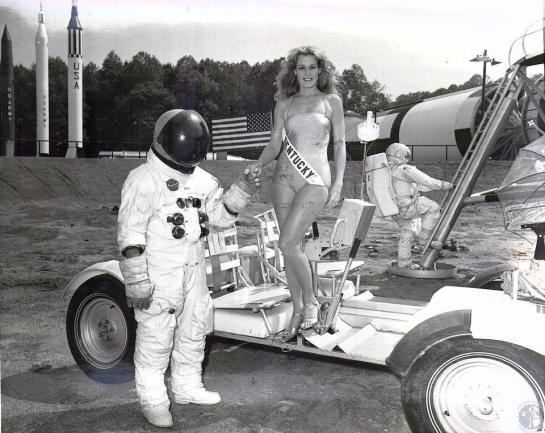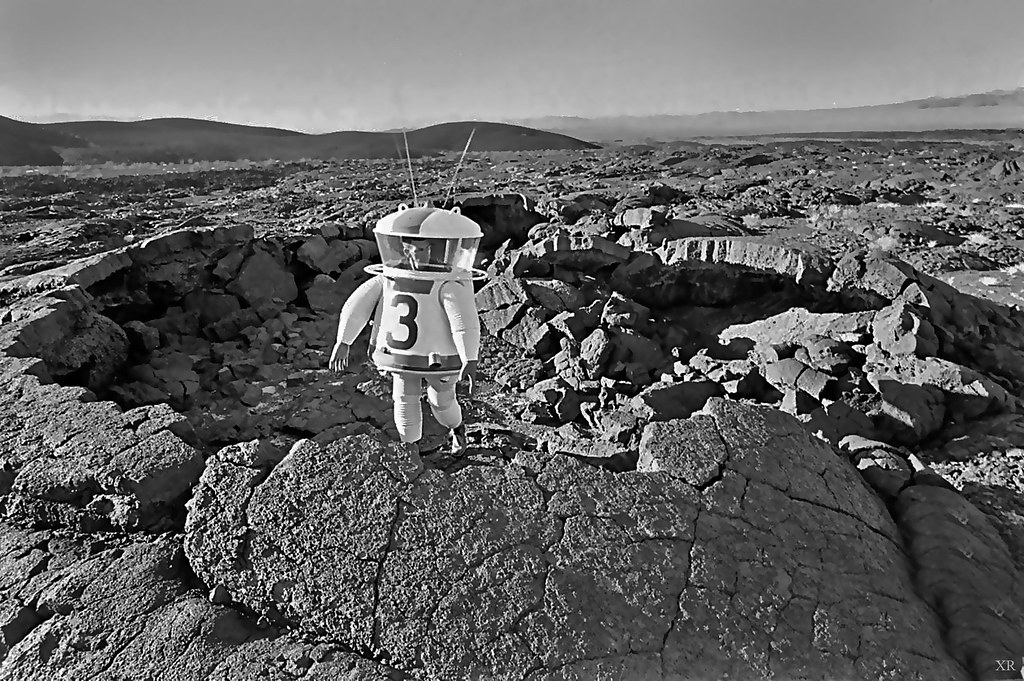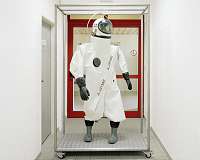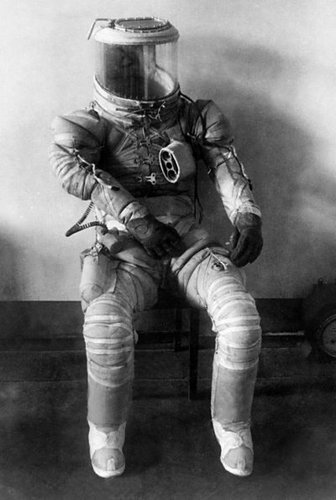- Joined
- 9 October 2009
- Messages
- 21,979
- Reaction score
- 13,647
https://science.slashdot.org/story/18/07/27/219203/an-open-source-diy-spacesuit-is-about-to-get-its-first-life-or-death-test
Hmmmm.
Hmmmm.
Grey Havoc said:https://science.slashdot.org/story/18/07/27/219203/an-open-source-diy-spacesuit-is-about-to-get-its-first-life-or-death-test
Hmmmm.
Grey Havoc said:https://www.thedailybeast.com/nasas-space-suit-drama-could-delay-our-trip-to-the-moon
Sigh.
Michel Van said:a ID request from Hoonte out NASASpaceFlight.com Forum
I think that's flight suit with experimental Flight helmet
got someone more info on that ?

Miss Kentucky (year?) about to step out of one of the 1-gravity trainer LRV used in happier times to give the Apollo astronauts instruction in the operation and driving practice of the real rover. The helper is wearing a definitely tired Command Module pilot (CMP) A7L space suit topped with a very rare early red Lunar Extravehicular Visor Assembly (LEVA).
Photo taken at the Space and Rocket Center Museum, Huntsville, Al (thanks, Alan). A Saturn rocket lying on the dirt and this. All very sad.


From last year:
From last year:








Early Soviet suits:
In Russian language for these suits (and, also, for diving armour), use term "skafandr" (Rus. скафандр, based on Greek "skafos" - boat, and "andros" - man, "boat-man"), but, also, in late XIX - early XX century, "skafandr" - name of pressurized cab. First "skafandr" for aeronauts in Russia suggested by engineer Pilchikov in 1890, but I haven't data about construction - it was a normal suit or massive cabine.
The most important thing of these historical sketeches was not the space suit per se, rather than the very first design of a practical airlock.Konstantin Tsiolkovkiy, USSR, 1933:
A 1963 USAF report describes work on an emergency “space suit.” It’s meant to be something that can be worn as a normal outfit and then zipped up at a moments notice in the event of a pressure drop. This includes a flexible helmet with a flexible “faceplate.” the end result looks like something out of a bad 1970’s pre-Star Wars disco-era sci-fi flick. Note, though that the actual test item is substantially less Giant Polyester Leisure Suit Lapels and more Cheap Plastic Poncho.
[W]ith the new industry request, NASA has done that. Bidders can use the technology NASA developed for xEMU in its proposals, or they can use their own designs, the document states. The suits must be able to meet a variety of requirements, including up to six spacewalks on the lunar surface during initial Artemis Moon missions. They must also be made of materials such that less than 100 grams of lunar regolith is brought back into the "cabin environment" after each spacewalk on the Moon. NASA plans to award a contract by next April.

After years of futility, NASA turns to private sector for spacesuit help
“A flight-ready suit remains years away from completion.”…arstechnica.com
[W]ith the new industry request, NASA has done that. Bidders can use the technology NASA developed for xEMU in its proposals, or they can use their own designs, the document states. The suits must be able to meet a variety of requirements, including up to six spacewalks on the lunar surface during initial Artemis Moon missions. They must also be made of materials such that less than 100 grams of lunar regolith is brought back into the "cabin environment" after each spacewalk on the Moon. NASA plans to award a contract by next April.

After years of futility, NASA turns to private sector for spacesuit help
“A flight-ready suit remains years away from completion.”…arstechnica.com
[W]ith the new industry request, NASA has done that. Bidders can use the technology NASA developed for xEMU in its proposals, or they can use their own designs, the document states. The suits must be able to meet a variety of requirements, including up to six spacewalks on the lunar surface during initial Artemis Moon missions. They must also be made of materials such that less than 100 grams of lunar regolith is brought back into the "cabin environment" after each spacewalk on the Moon. NASA plans to award a contract by next April.

After years of futility, NASA turns to private sector for spacesuit help
“A flight-ready suit remains years away from completion.”…arstechnica.com
I don't really get the whole "turning to the private sector" angle--NASA hired numerous companies in the past to build its spacesuits such as ILC Dover. Oceaneering worked on a lot of EVA equipment, as did other companies. These may be changes in contracting rules, but commercial companies have long built and maintained NASA spacesuits.
Given that Space tourists (hitchhikers) have the budget and would be pleased to have them custom made as, probably, keeping them as a souvenir post flight, there should be no doubts that there is an interesting market
Would you enjoy as much your cruise in the Bahamas if you were alloted standards Bob hats, red shorts and standardized Hawaiian shirt?
The idea is that the "private sector" could/would suddenly find a reason to build space suites vastly cheaper than they (the private sector) already do. For 'someone' other than NASA but NASA would end up paying for it. It's the same as the general launch market since "SpaceX" greatly reduced the general price of launches, (even though NASA paid for it) thinking that somehow there is a market for space suits.
The idea is that the "private sector" could/would suddenly find a reason to build space suites vastly cheaper than they (the private sector) already do. For 'someone' other than NASA but NASA would end up paying for it. It's the same as the general launch market since "SpaceX" greatly reduced the general price of launches, (even though NASA paid for it) thinking that somehow there is a market for space suits.
You wrote a bunch of words that don't say anything. ILC Dover is a commercial company. Hamilton-Sunstrand is a commercial company. Commercial companies have been involved in spacesuit development since the beginning of the space program. This is a change in contracting methods, not some fundamental shift.
Private sector contractors know their customers. For example, Morton's contracted me to write "Lockheed SR-71 Blackbird: Origins and Evolution." There was a certain dollar amount attached to that. But if the United States Friggen' Government had come along and said "We need you to write this book on the SR-71 and price is no object..." yep, I'm'a gonna do it for the low, low, incredibly low price of a few million dollars more than Mortons paid me. Why? Because:
1: The US government *has* that much more money
2: Government bureaucrats either don't understand the value of a dollar or don't care, and thus it is my moral, legal, ethical and financial responsibility to soak them as heavily as possible.*
So a private spacesuit contractor that charges the government many millions of dollars for a space suit might well figure out that they can make a decent profit off selling a slightly simplified version to private individuals for several orders of magnitude less.
* When I stand before Crom and he asks "what is the riddle of government contracting," if I don't answer with "why buy one when you can get two at twice the price," he will laugh at me and throw me out of Valhalla.
Given that Space tourists (hitchhikers) have the budget and would be pleased to have them custom made as, probably, keeping them as a souvenir post flight, there should be no doubts that there is an interesting market
Would you enjoy as much your cruise in the Bahamas if you were alloted standards Bob hats, red shorts and standardized Hawaiian shirt?
"Price is not an object" (it is actually as what it costs to produce an actual suit to the proper specifications is NOT cheap by any means as nations like China and India have found out) has a tendency to be the default when you can't afford failure. Couple that with a very low production rate, low demand and limited market and of course the cost is going to be high. IVA suits aside there's no real 'competition' to be had and unlikely to be much bigger even if things like Space Tourism to orbit actually takes off.
(how much would that book cost if you and Morton KNEW they were only going to sell a few copies and you and they still had to make a profit?)

Ppl don't sign for a cruise to down a survival suit!Would you enjoy as much your cruise in the Bahamas if you were alloted standards Bob hats, red shorts and standardized Hawaiian shirt?
Point of fact in the industry it wouldn't MATTER in that context because the whole 'point' of the 'cruise' is to build an experience not to focus on any single aspect. You were SO close btw on the point but you missed it:
"Would you enjoy as much your cruise to the Bahamas if you were allotted a "standard" life jacket? You would? Great, because you don't get to bring your own anyway. The "hat/shorts/shirt" is an IVA suit, the "life jacket" is an EVA suit. And btw cruises in extreme areas (Northern and Southern polar regions) ALSO have a 'standard' survival suit for each 'guest' and crew member stored on-board so again the thing is they are there as examples already. And no, they are not 'cheap' either and are strictly generic in nature.
Randy
"Price is not an object" (it is actually as what it costs to produce an actual suit to the proper specifications is NOT cheap by any means as nations like China and India have found out) has a tendency to be the default when you can't afford failure. Couple that with a very low production rate, low demand and limited market and of course the cost is going to be high. IVA suits aside there's no real 'competition' to be had and unlikely to be much bigger even if things like Space Tourism to orbit actually takes off.
Yeah, but is space tourism takes off, especially so if space *industrialization* takes off, "low production rate" may go right out the window, with standardized bits and pieces stuck together to make more or less fitted suits.
Ppl don't sign for a cruise to down a survival suit!
Similarly, EVA (but with not much activity) will be a demand for the market. So, sooner or later, customization will apply.
Not necessarily, EVA is not a big 'draw' for Space Tourism...
